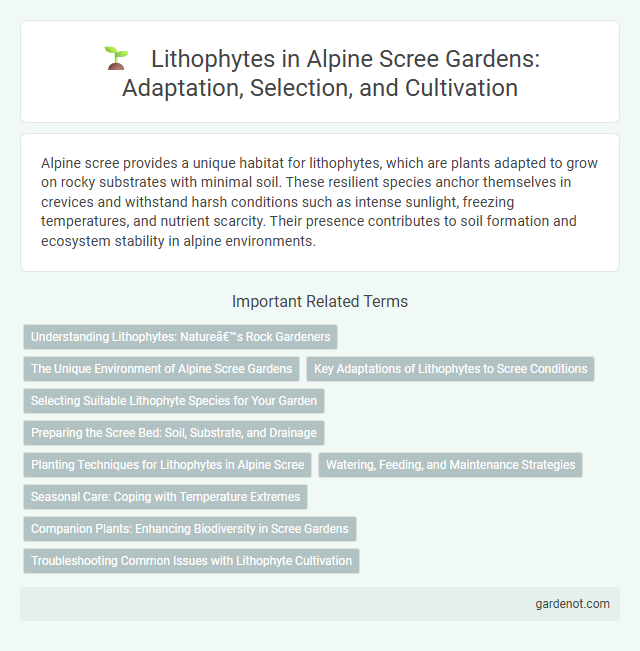Alpine scree provides a unique habitat for lithophytes, which are plants adapted to grow on rocky substrates with minimal soil. These resilient species anchor themselves in crevices and withstand harsh conditions such as intense sunlight, freezing temperatures, and nutrient scarcity. Their presence contributes to soil formation and ecosystem stability in alpine environments.
Understanding Lithophytes: Nature’s Rock Gardeners
Lithophytes are specialized plants adapted to grow on rocky substrates, thriving in alpine scree environments where soil is minimal or absent. These resilient plants anchor themselves in crevices, extracting nutrients from weathered minerals and organic debris, playing a crucial role in stabilizing loose rock and preventing erosion. Their presence contributes to biodiversity and initiates ecological succession, gradually transforming barren scree into supporting habitats for other plant and animal species.
The Unique Environment of Alpine Scree Gardens
Alpine scree gardens host specialized lithophytes uniquely adapted to thrive on rocky, nutrient-poor substrates with extreme temperature fluctuations. These plants anchor themselves in crevices, extracting moisture from dew and minimal soil, showcasing remarkable resilience to wind and frost. The microhabitats within alpine scree create a distinct ecological niche supporting diverse lithophyte species.
Key Adaptations of Lithophytes to Scree Conditions
Lithophytes thrive in alpine scree environments by developing specialized root systems that anchor them within loose, rocky substrates, maximizing water absorption in drought-prone conditions. Their leaves often exhibit thick cuticles and reduced surface areas, minimizing water loss while optimizing photosynthesis under intense sunlight and temperature fluctuations. Furthermore, lithophytes employ efficient nutrient uptake mechanisms adapted to nutrient-poor scree, enabling survival and growth amidst harsh alpine conditions.
Selecting Suitable Lithophyte Species for Your Garden
Choosing suitable lithophyte species for an alpine scree garden involves prioritizing plants that naturally thrive on rocky substrates with minimal soil. Species such as Saxifraga, Sedum, and Sempervivum demonstrate exceptional adaptation to harsh, well-drained environments and provide vibrant texture and color. Selecting drought-tolerant, slow-growing lithophytes enhances garden sustainability and mimics natural alpine scree conditions effectively.
Preparing the Scree Bed: Soil, Substrate, and Drainage
Lithophytes thriving in alpine scree require well-drained, coarse soil substrates rich in mineral content that mimic natural rocky habitats. Preparing the scree bed involves incorporating sharp sand, gravel, and crushed stone to enhance drainage and prevent water retention that can cause root rot. Optimal drainage is achieved by layering materials to facilitate air circulation and moisture control, creating an ideal environment for lithophyte root systems.
Planting Techniques for Lithophytes in Alpine Scree
Planting lithophytes in alpine scree requires selecting well-drained, gritty substrates that mimic natural rocky habitats and prevent waterlogging. Positioning plants in crevices or among stable stones offers protection and support while facilitating root anchorage and moisture retention. Regular monitoring for erosion and occasional mulching with coarse materials enhances establishment success in harsh alpine conditions.
Watering, Feeding, and Maintenance Strategies
Lithophytes in alpine scree environments thrive with minimal watering, ideally using rainwater or distilled water to prevent mineral buildup. Feeding should involve diluted, low-nutrient fertilizers applied sparingly during the growing season to mimic natural nutrient-poor conditions. Maintenance strategies include ensuring excellent drainage, avoiding overwatering, and periodically removing debris to prevent mold and root rot.
Seasonal Care: Coping with Temperature Extremes
Lithophyte plants in alpine scree habitats demonstrate remarkable adaptation to seasonal temperature extremes, utilizing specialized root systems to anchor in rocky substrates and access limited moisture. During harsh winters, these plants enter a dormancy phase, reducing metabolic activity to survive freezing conditions. In summer, their physiological mechanisms enhance water retention and photosynthetic efficiency, enabling growth despite intense sunlight and drought stress.
Companion Plants: Enhancing Biodiversity in Scree Gardens
Lithophyte companion plants such as saxifrages, alpine sedums, and cushion plants enhance biodiversity in alpine scree gardens by providing varied microhabitats and stabilizing soil. These plants thrive on rocky substrates, promoting ecological balance and supporting pollinators sensitive to harsh mountain environments. Integrating diverse lithophytes with complementary growth habits improves resilience and visual interest in scree garden ecosystems.
Troubleshooting Common Issues with Lithophyte Cultivation
Lithophyte cultivation in alpine scree environments often faces issues like inadequate drainage and nutrient deficiency due to rocky substrates. Ensuring proper soil composition with added organic matter and maintaining consistent moisture levels helps prevent root rot and nutrient stress. Regular monitoring and adjusting pH levels between 5.5 and 7.0 optimize lithophyte growth and resilience.
Lithophyte Infographic

 gardenot.com
gardenot.com